
You’re in the Wright Place!

Racine , Tours , Wisconsin , Wisconsin Trail
Sc johnson research tower (1936).
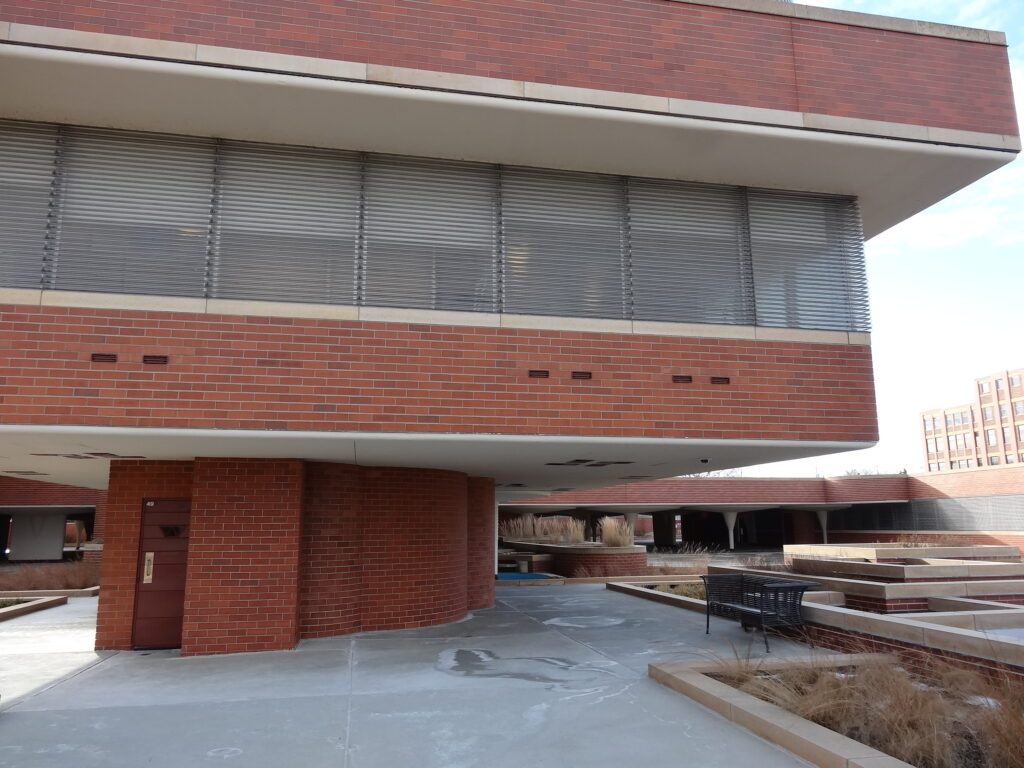
Touring the SC Johnson Research Tower is like taking a giant step back in time… for several reasons. The tour takes you back to the age of test tubes, scales, gas ports and hand-written notes – giving one a real feel for what it might have been like to work in a 1950’s research laboratory. It also allows one to see just how innovative and forward-thinking and ahead of his time Frank Lloyd Wright really was.
A UNIQUE TOWER The fifteen-story, 153-foot tall Tower was built on the principle of the cantilever; the reinforced concrete slab floors are horizontal extensions from a central “taproot” core, the base of which extends more than fifty feet into the earth below. The Tower was home to the invention of many of SC Johnson’s landmark products. We are all familiar with trusted names like Raid®, OFF!®, Glade®, and Pledge® – all developed in the mid- to late-1950’s and sold around the world today.
There are actually two different kinds of floors/levels in the building: square bands of bricks (more than 22,000 of them), in beautiful and serene Cherokee Red, a Wright/SC Johnson signature color – as viewed from the exterior – are main floors and are square in shape on the interior; the floors in-between them feature the same kind of Pyrex glass tubes used in the Administration building and are the mezzanine/circular levels. Open communication within a department – necessary for collaboration – was made easily possible using this main floor-mezzanine floor design, i.e., each department had a main floor and a mezzanine floor.
Running through the core of the building are a circular elevator (unfortunately no longer able to be used) and a lighthouse-style circular and rather narrow stairway. From the second floor, there is also a narrow bridge with an arch of glass tubes that connects the Research Tower to the Administration Building.
NOKOMIS AND NOKOMA Guarding the front of the building are two giant stone statues of Native Americans. On the west side of the sidewalk is the seventeen-feet tall Chief Nokomis; on the east side is the thirteen-feet tall statue of his wife Nokoma, both designed by Wright and commissioned on the campus in 1977. The building was a marvel and was given great reviews… by almost all except employees, who complained of the leaking seals between the joints connecting the Pyrex glass tubing, as well as the extreme brightness they allowed into the structure. Many complained and even demanded sunglasses.
By 1982, the research needs became so great that SC Johnson opened another facility for its ever-expanding research department. Unfortunately, safety concerns and newer building codes resulted in the ultimate abandonment of the Tower; evacuation would be extremely difficult with only one narrow staircase to use. Even so, the company decided in 2013 to undertake an extensive renovation project.
Completed in 2014, the Tower’s lower floors are now available for tour by the public. The Tower stands proud and tall and remains testament to the genius of Frank Lloyd Wright and the solid bond of friendship and respect developed between he and SC Johnson.
RELATED ARTICLES, MEDIA, RESOURCES & LINKS SC Johnson – corporate website Wingspread located just north of Racine in Wind Point, WI Thomas Hardy House located just 1/2 mile from the SC Johnson campus MORE INFORMATION
LOCATION Howe & 16th St Racine, Wisconsin 53404
TOURS Tours of the SC Johnson Campus and of Wingspread are free and open to the public but advance reservations are required. Click here to make your reservation.
Photographs are allowed of the exterior of the buildings on the SC Johnson campus but no interior photography is allowed.
Frank Lloyd Wright’s SC Johnson Research Tower by Mark Hertzberg
The Wright State: Frank Lloyd Wright in Wisconsin
Share This FLW Site
Related articles.

Corbin Education Center (1957)
The Corbin Education Center and is a part of Wichita State University and was formerly known as the Juvenile Cultural Center. Photo Credit: Wichita State
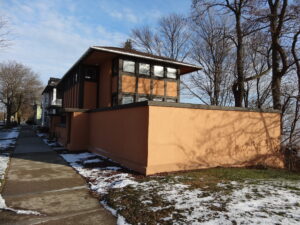
Thomas P. Hardy House (1905)
It may be quite difficult to imagine what Racine Wisconsin looked like in 1905. But a Google Maps search for the city at that time
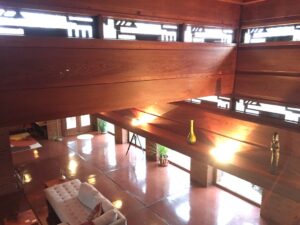
Bernard Schwartz House (1939)
TOUR STILL BEND The Schwartz House is open for tour on specific days throughout the year. Most tours start at 2 pm and last for
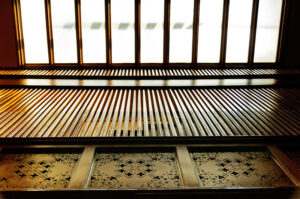
Charnley-Persky House (1892)
The Charnley-Persky House was designed by Louis Sullivan but we’ve included it on this website because of Sullivan’s influence on Wright and Wright was a
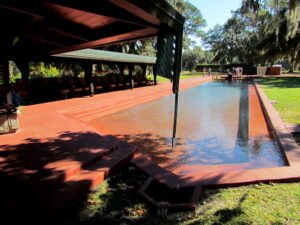
Auldbrass Plantation

O’Connor House (1916)

McCartney House (1949)
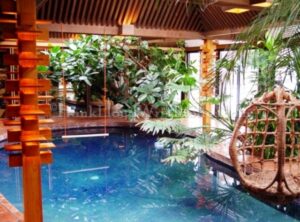
Don Erickson Estate
For your home.

Yvonne Carpenter-Ross
Flw enthusiast & webmaster.
Architecture and home design have always fascinated me. As a young girl I enjoyed drawing floor plans, rearranging my parent’s furniture and playing with Lincoln Logs and Legos. My passion has always been the architecture of Frank Lloyd Wright. Since I have been old enough to drive a car, I have visited Frank Lloyd Wright homes in the Chicagoland area and attended the Wright Plus house walks. Now, as co-owners of Northern Sky Designs , my husband & I are able to combine our website design skills and FLW travels to bring you this website! Enjoy!
Follow me on Instagram
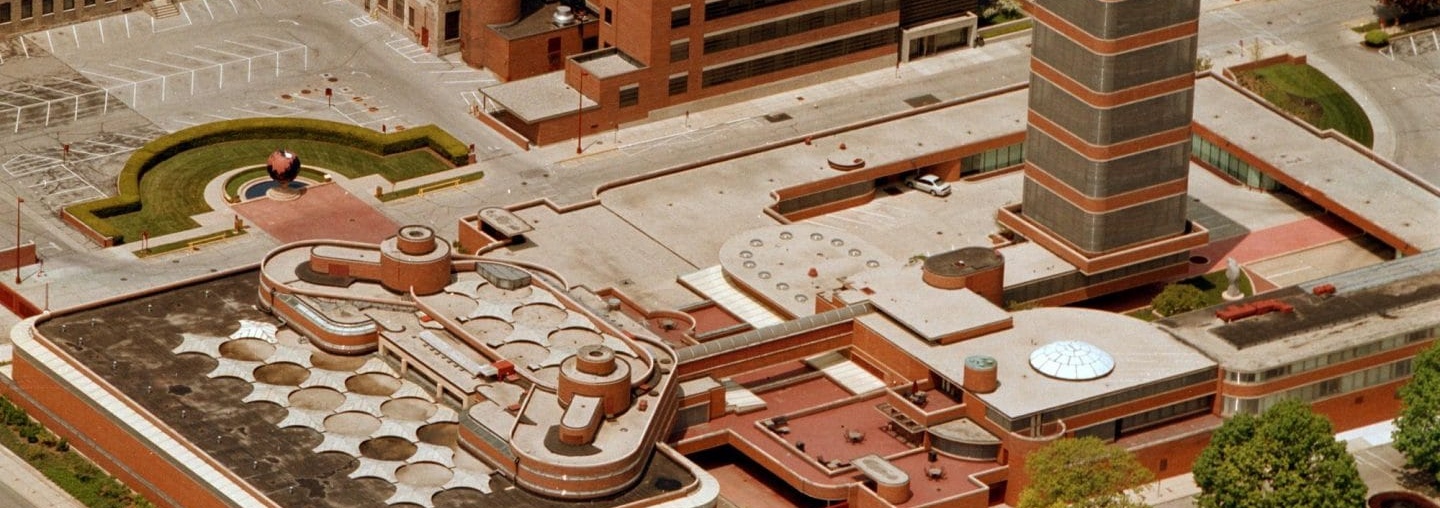
S.C. Johnson Administrative Complex
When the Johnson Wax Administration Building was completed Life magazine called it the greatest innovation since the skyscraper: “a truer glimpse of the shape of things to come.” Like Wright’s Larkin Administration building of 1903, Wright desired to build an exhilarating work environment, even suggesting that it be moved out of the bleak industrial zone of Racine for which it was planned.
Herbert F. Johnson
Golden Rondelle Theater
National Historic Landmark. National Register of Historic Places. Open to the public with tours available.
scjohnson.com
When Herbert Johnson refused to turn his back on his company’s hometown, Wright designed the building without windows, explaining that as “nature was not present” in the environment, his design would “recreate nature” on the interior. The result, Wright promised, would be like working in a pine forest glade, with fresh air and sunlight all of the time. Wright achieved his vision with the help of two important innovations: steel mesh-reinforced concrete and glass tubing. The concrete allowed him to build slender white columns that rose tendril-like from their nine-inch bases to eighteen-foot-wide circular concrete “lily pads” that support the roof. The tubing allowed much of the roof and clerestory to filter perfectly diffuse light between the lily pads, creating a space that, without traditional windows, is the very essence of light. Due to the fact that the available technology could not properly seal the glass tubing, the roof leaked every time it rained. Herbert Johnson took to keeping a bucket on his desk to catch the drops.
The construction of the Johnson Wax Administration posed significant challenges and costs, originally budgeted at $200,000, kept rising. “First, Frank Lloyd Wright was working for me,” Johnson recounted: “Then we were working together. Finally, I was working for him.” Despite spending some $900,000 to see his headquarters finished, Johnson was so enamored of Wright’s genius that he would go on to employ Wright to design both his personal home and the new headquarters for the company’s research and design division. The resulting fourteen-story research tower is connected to the main building by a covered bridge. Reinforced concrete slabs, cantilevered from the building’s central core, form the alternating square floors and circular balconies. Though the Research Tower is no longer in use because of a change in fire safety codes, an extensive restoration completed in 2013 has enabled the tower to be open for public tours for the first time in its history.

Similar Projects Commercial Midwest
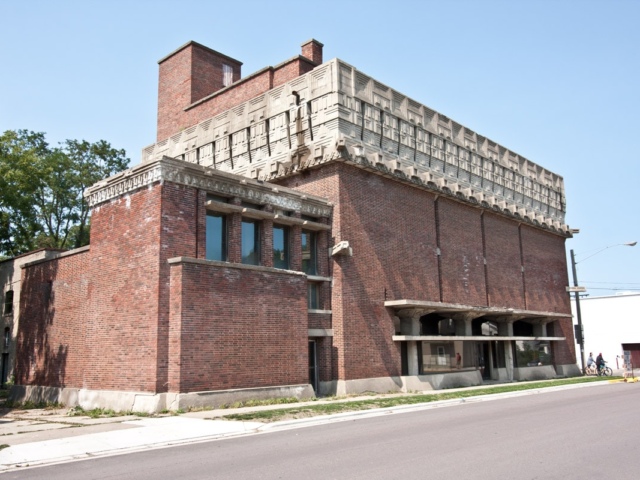
A.D. German Warehouse
Richland Center, WI 1917

Historic Park Inn Hotel
Mason City, IA 1909
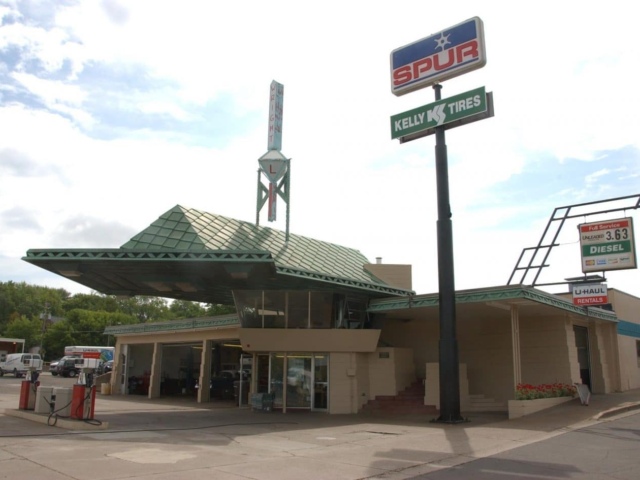
Lindholm Oil Company Service Station
Cloquet, MN 1956
See more of Frank Lloyd Wright’s work
The Whirling Arrow
News and updates from the Frank Lloyd Wright Foundation
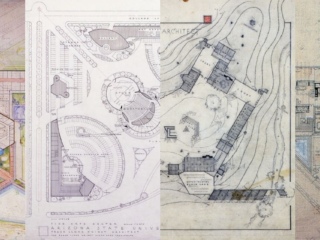
Frank Lloyd Wright + Arizona
Frank Lloyd Wright’s connection to Arizona, the location of his personal winter home Taliesin West, runs deep, with his architectural influence seen all over the Valley. Here, PhD student David R. Richardson gives a brief overview of several of Wright’s most notable projects in the Grand Canyon state.
![sc johnson tours [Cohen House Tropical Foliage (Abstract Pattern Study), Eugene Masselink, ca. 1957, graphite, ink, and paint on plywood, Frank Lloyd Wright Foundation Collection, 1910.223.2.]](https://franklloydwright.org/wp-content/uploads/2024/04/1910.223.2-2-a-320x240.png)
Celebrating World Art Day April 15, 2024

Factory Tours
Celebrating american imagination and industry.
Your browser is not supported for this experience. We recommend using Chrome, Firefox, Edge, or Safari.

E-news Sign up
Stay up-to-date and in-the-know with everything MKE

Partner Portal
Login to manage your partnership account
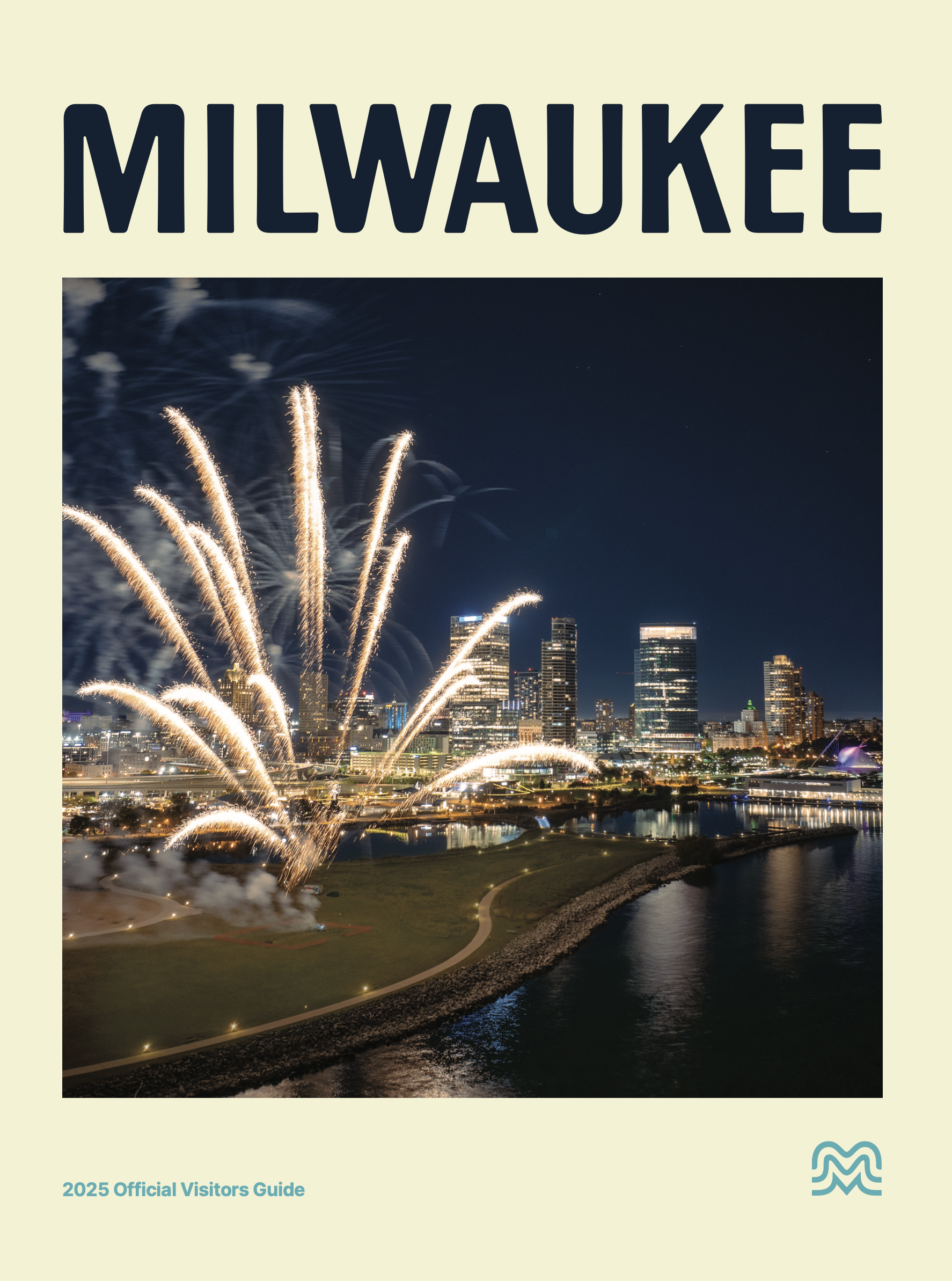
Visitors Guide
Read great stories and find insider tips about Milwaukee
Alive! and Well: Celebrating SC Johnson’s Spirit of Adventure Sixty Years After its World’s Fair Debut
- HF Johnson Jr
Fairgoers were immediately drawn to a gold, circular building on the rainy spring morning the New York World's Fair opened on April 22, 1964. The building, held up by six concrete columns, was a makeshift sun parting through the gloomy clouds as they lined up, craning their necks to get a glimpse inside. Nothing could dampen their excitement as the sound of Mozart mingled with the falling rain around them. The sweet scent of Belgian waffles still filled their noses as they waited to enter what would become one of the fair's most popular exhibits: The Johnson's Wax Pavilion and the film To Be Alive!
By the time the fair closed in October of 1965, more than five million visitors had gone through the company’s pavilion and seen the 18-minute film they produced. Some had even waited up to two hours to watch it. Former U.S. President Dwight Eisenhower called it “... a most imaginative film and very beautifully done. It shows the world through the children's eyes, where there is no room for prejudice or arrogance.”

This year marks the 60th anniversary of the fair and the debut of the widely celebrated film, and today, it continues to highlight SC Johnson’s commitment to making the world a better place today and for future generations.
In planning the pavilion and film, the company’s third-generation leader, H.F. Johnson, Jr., had taken the fair’s theme, “Peace Through Understanding,” to heart and wanted to bring something that celebrated life rather than just tout the different products SC Johnson offered. A visionary man, H.F., Jr. was unafraid to take the company in directions no one expected from a simple floor wax business out of Racine, Wisconsin. SC Johnson’s executives and vice president Sam Johnson, who was H.F., Jr.’s son, were very hesitant to put over a third of the company’s advertising budget into this project. Sam Johnson told his father, “It isn’t going to sell any more of our products” and would most likely “hurt the business.” H.F., Jr. responded, “Sam, some decisions are only for the brave.”
H.F. Johnson, Jr. gave directors Francis Thompson and Alexander Hammid complete creative control over the project, resulting in a film highlighting the little joys in life that children all over the world, no matter their culture, experience as they grow into adulthood. The official guidebook from the fair described To Be Alive! as showing the daily lives of people around the world, where “they grow up, fall in love, work, play and grow old, demonstrating that ‘men everywhere share at the deepest level the same drives, dreams, foibles.’”
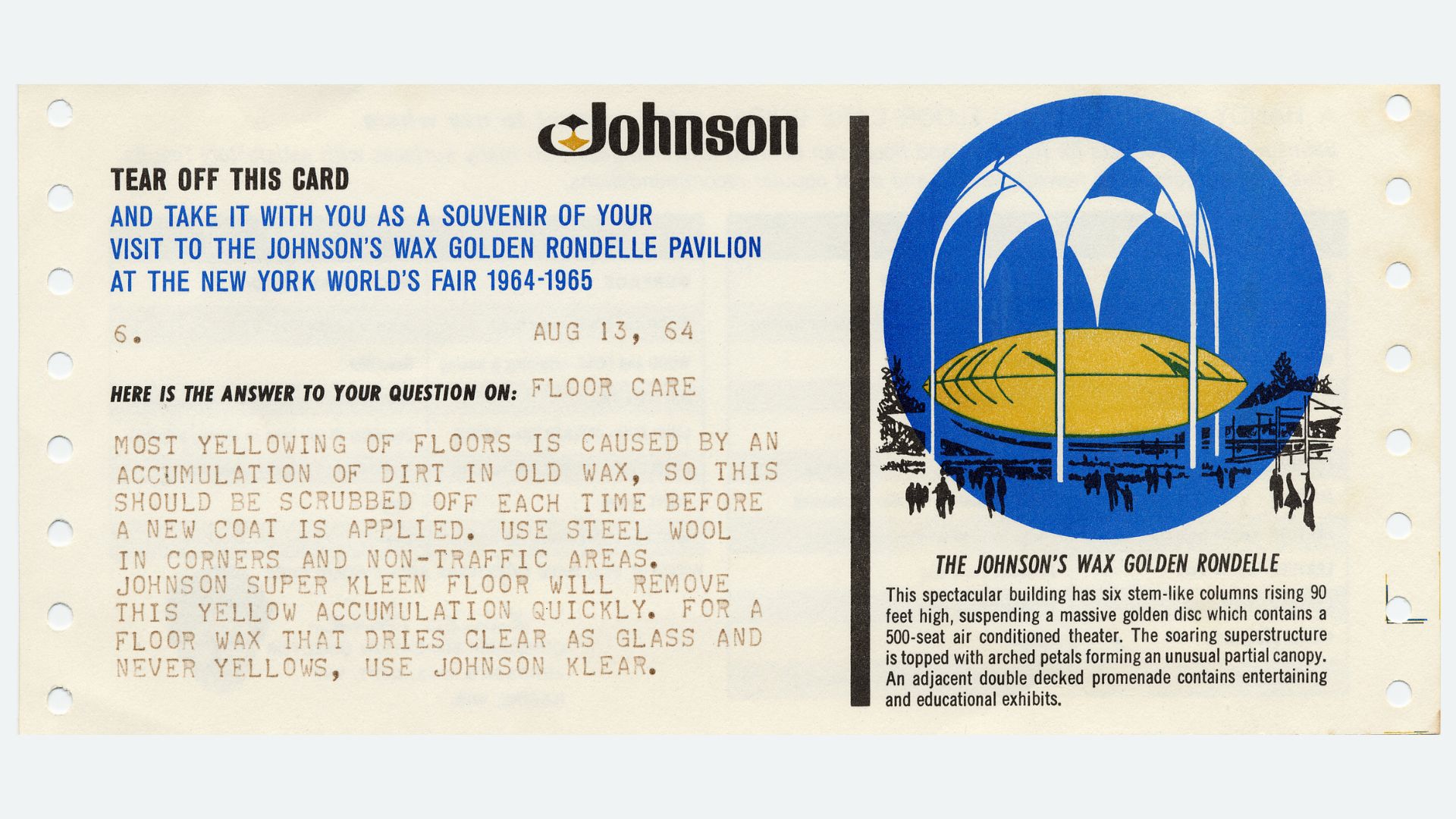
Stills from the 1964 film To Be Alive!
A Showcase of Cultures
The New York World’s Fair in 1964-65 was unique for many reasons. First, the Bureau of International Expositions, which was the international body that sanctioned world’s fairs, did not endorse it. To afford the cost of the New York World’s Fair, its organizers wanted the fair to run for two six-month sessions and planned to charge exhibitors a fee for constructing their pavilion. Both conditions were against the Bureau’s rules, who proceeded to request its member nations refuse the invitation to participate in New York.
This refusal was the catalyst for the second reason the fair was so unique. With the absence of many European nations, there was now space for smaller, non-European nations to participate. Countries around the world, from Morocco to Venezuela, were able to attend and share their language, food and culture with U.S. fairgoers. More than 60 different nations ended up participating in the fair, and for many of them, inclusion was significant as they were still in their infancy. Thirty nations even created commemorative postal stamps to celebrate their involvement. Some participating countries, like Guinea, had been established less than ten years before the fair, and others, like Malaysia, were only a year old.
As a result, the New York World’s Fair became a memorable example of the intersection of cultures that was to come as the United States’ population and demographics increased. In the three decades following 1965, more than 18 million immigrants from around the world would come to the U.S.
Delicacies like Belgian waffles “sold like hotcakes” at the fair as many were tasting them for the first time, and many international pavilions offered dining forays that most Americans had never experienced. Japan’s pavilion served its food on low tables and prohibited shoes, and the Indonesian pavilion had traditional dancing and music playing while people ate.
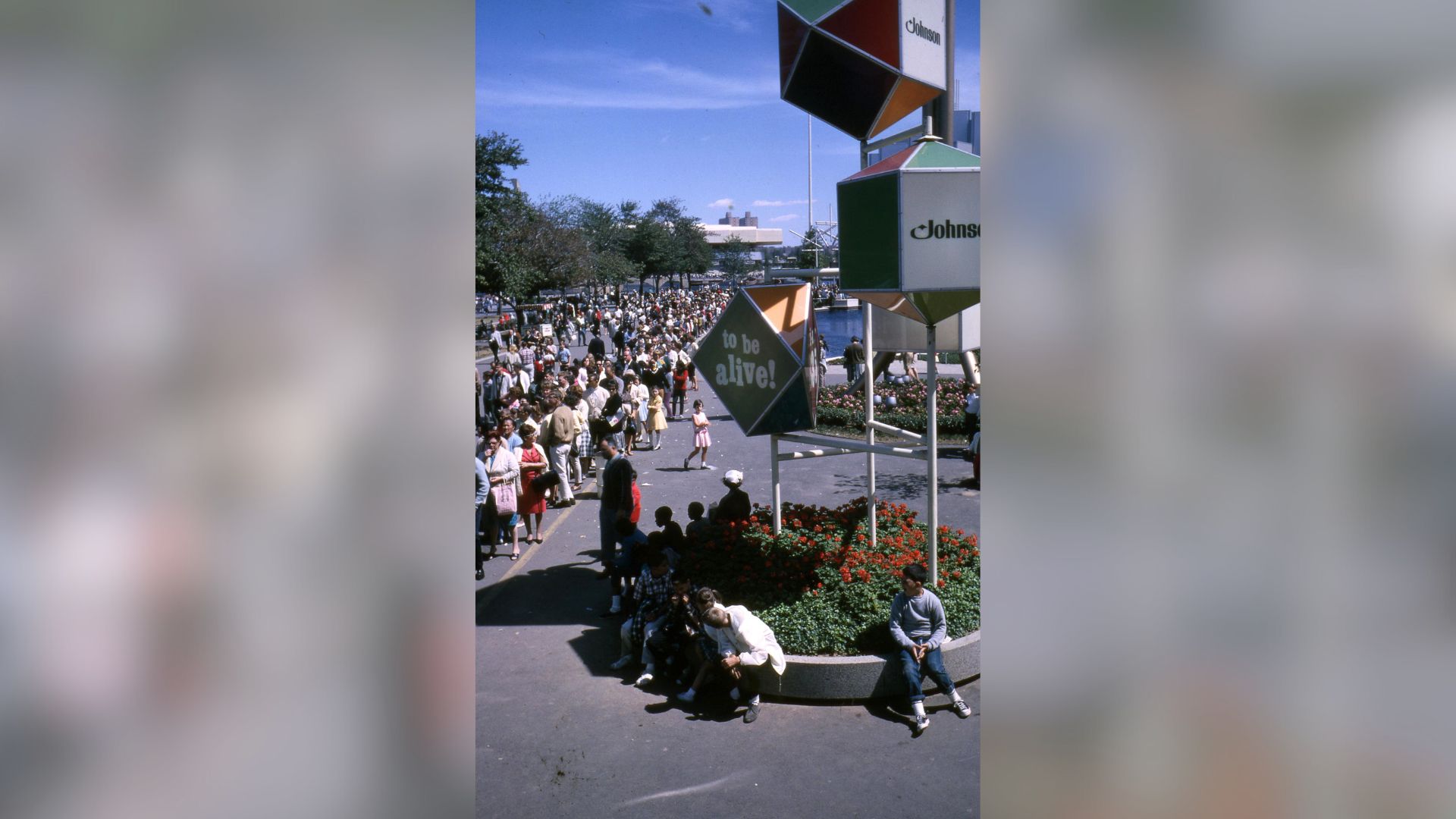
Man's Achievement on a Shrinking Globe in an Expanding Universe
Along with highlighting many different countries around the world, the 1964-65 World’s Fair also became a showcase for the incredible technological advances the world was making at the time. The organizers aptly dedicated the fair to “Man’s Achievement on a Shrinking Globe in an Expanding Universe.” NASA exhibited several full-scale models of a rocket, its engine, and even the first two capsules scientists were developing to send astronauts to the moon.
Jetpacks and “picturephones” were also introduced during the 1964-65 fair. “ Picturephones ,” as Bell System called them, were the first iteration of video conferencing. The phone was connected to a small video screen where the caller could see the other person on the phone. Picturephones were also set up in Disneyland in California so fairgoers could see and talk to park visitors on the other side of the country.
Even the iconic Ford Mustang was introduced at the fair. Mustang convertibles and other late-model Ford cars were on a moving conveyor belt for fairgoers to hop in and ride back to the age of the dinosaurs. This “ride” was created and narrated by Walt Disney especially for the fair. Well-loved Disney attractions like “It’s a Small World” and the “Carousel of Progress” were also created for the fair, as part of the UNICEF pavilion and the General Electric Pavilion respectively.
SC Johnson’s film To Be Alive! could be considered another example of technological advancement at the fair. The film was one of the first to use a multi-screen format instead of the traditional one screen. Inside the Johnson Wax’s pavilion, 500 people at a time could watch To Be Alive! play on three 18-foot screens separated by a foot of space. In 1966, the film’s directors even won an Academy Award for it.
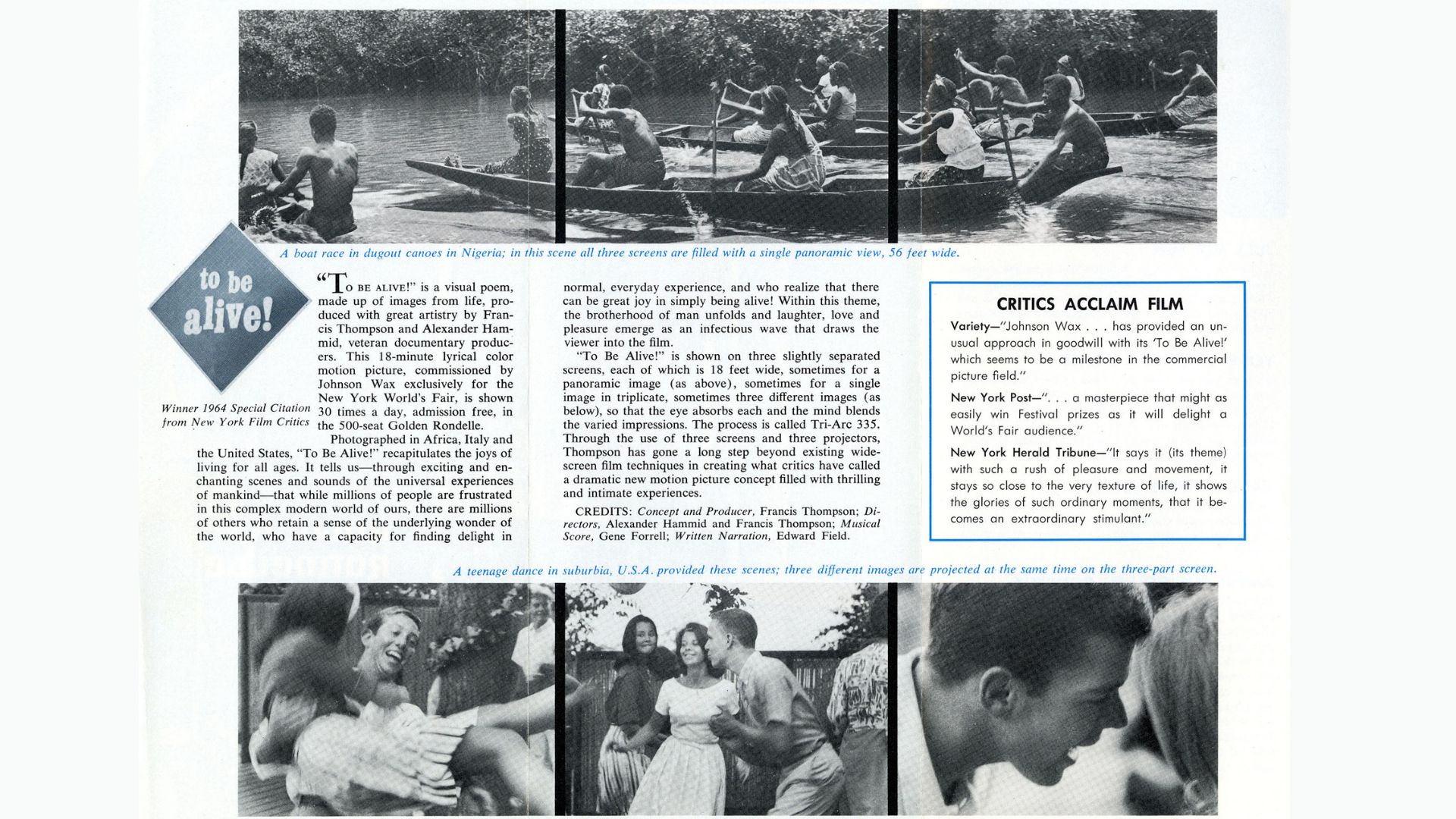
After the Fair
After two six-month runs, bringing in over 50 million visitors , the New York World’s Fair ended. To keep the adventurous spirit of the company alive, SC Johnson dismantled the pavilion and brought it home to Racine. At its global headquarters, it was renamed the Golden Rondelle Theater and redesigned by the Taliesin Associated Architects to fit in with the company’s Frank Lloyd Wright-designed buildings. Today, the Golden Rondelle Theater acts as SC Johnson’s connection to the Racine community and the world. It is home to the company’s campus tour program, community interest programs and Kaleidoscope Education Series . The series provides STEM-based programs for children of all ages at no cost.
Since it opened in 1967, the Golden Rondelle Theater has held screenings of the film, though it was reduced to a single screen. In 2004, when the film and the fair celebrated its 40th anniversary, SC Johnson’s fourth-generation leader, Sam Johnson, restored the film to the original triple-screen format.
Today, To Be Alive! is available for the public every weekend and is part of SC Johnson’s campus tours that over 1 million people worldwide have taken. While there aren’t any Belgian waffles or classical music, the campus architecture, theater and film continue captivating crowds and inspiring future generations just as it did in 1964.
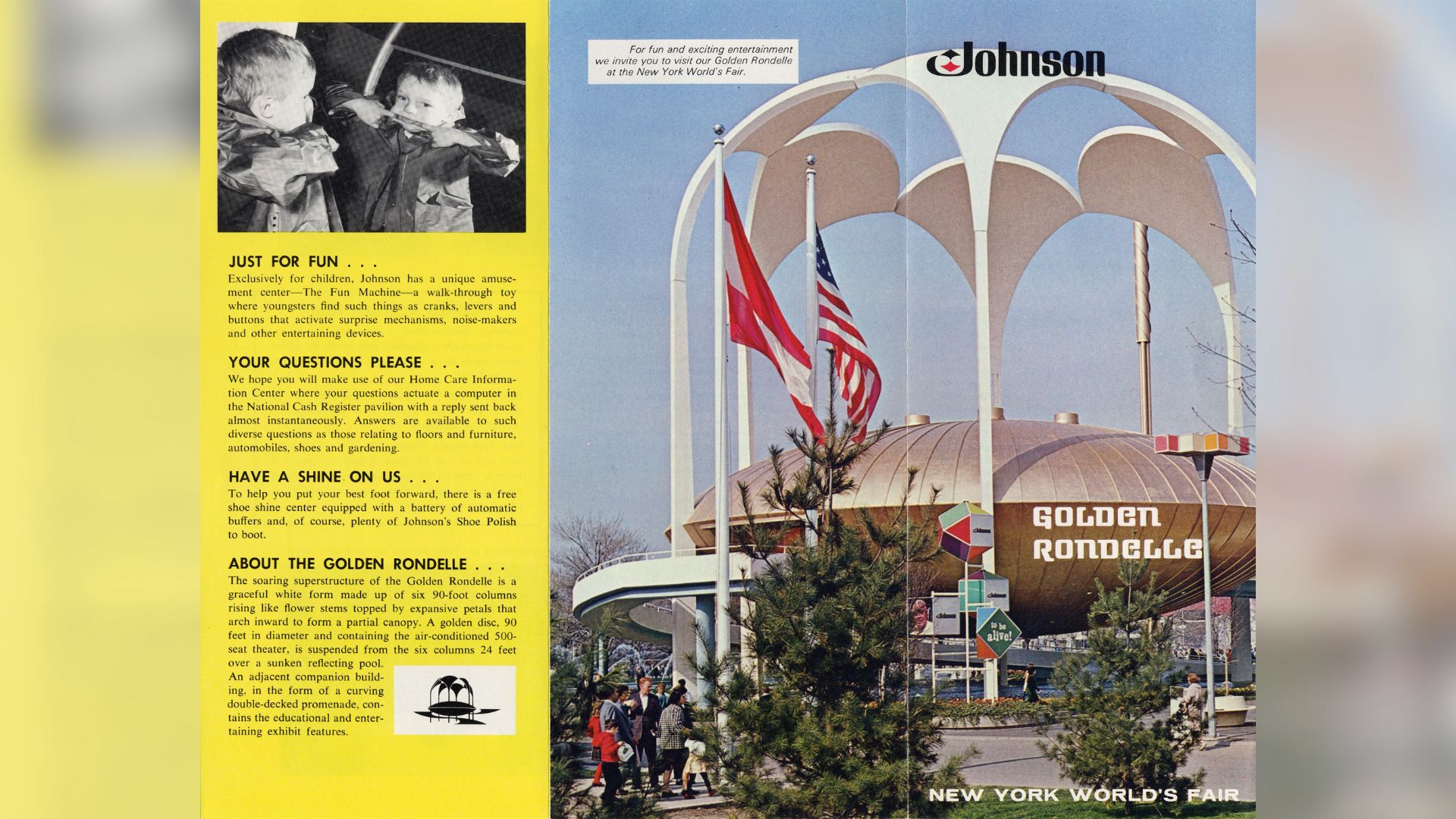

IMAGES
COMMENTS
You'll want to allow drive time if you are scheduling to visit both on the same day. Have a big group? SC Johnson campus tours of more than 20 people can be arranged by contacting SC Johnson at [email protected] or 262-260-2154. Group tours of Wingspread can be arranged via phone at 262-681-3353.
SC Johnson Campus Tour (Administration Building, Research Tower & Fortaleza Hall) Up to 1 hour, 30 minutes This tour is perfect for those who want a close, in-depth look at SC Johnson's inspired architecture as well as an understanding of the legendary partnership between third-generation company leader H.F. Johnson, Jr. and the renowned ...
Living Planet: An SC Johnson Company-Sponsored Film Brought a Bird's-Eye View of Nature to Millions. We all love a great story. That's why we're so proud that SC Johnson has created numerous films that have entertained and moved millions of people over the past 50 years. From our Frank Lloyd Wright-designed buildings to Fortaleza Hall and ...
Explore the Frank Lloyd Wright-designed buildings, Fortaleza Hall, and the new Waxbird Commons at SC Johnson's campus in Racine, Wisconsin. Learn about the history, culture, and sustainability of the company and its products.
We offer 90-minute SC Johnson Campus Tours Saturdays and Sundays beginning October 1, 2023 and ending May 1, 2024. 60-minute Wingspread Tours are offered on Saturdays and Sundays. If your group has more than 20 people, call us at 262-260-2154 to make special arrangements. SC Johnson tours begin at The Golden Rondelle Theater, at 1525 Howe ...
Tours at SC Johnson. Tours of the SC Johnson campus are free and open to the public with advance reservations. Tour options are listed below - check availability and make a reservation here. Full SC Johnson Campus. (Administration Building, Research Tower and Fortaleza Hall) Up to 1 hour, 30 minutes. This tour is perfect for those who want a ...
Located in Racine, Wisconsin, SC Johnson has the only remaining Frank Lloyd Wright-designed corporate headquarters that's still in use. Watch the videos below for an exclusive, in-depth look at our inspired architecture, and to learn what makes us a family company at work for a better world. SC Johnson Administration Building.
Guests should be comfortable standing, walking and climbing stairs, and tours include both indoor and outdoor spaces. Tours are geared toward adults, but children are allowed. Here are some additional FAQs specifically focused on Wingspread. If you have further questions, please call Wingspread at 262-681-3353 or email [email protected] .
From 1930s to 1950, third-generation company leader H.F. Johnson, Jr. and Frank Lloyd Wright produced remarkable and enduring architecture for SC Johnson. Love great architecture? You should visit! Since 1939, our SC Johnson buildings have become essential destinations for people who appreciate great design.
Wingspread Tour. Wingspread, the iconic, Prairie-style home that Frank Lloyd Wright designed for SC Johnson's third-generation leader is available for public tours. The free Wingspread tour highlights remarkable features such as the home's disappearing dining table, its teepee-inspired clerestory ceiling in the great room and the ...
LOCATION. Howe & 16th St. Racine, Wisconsin 53404. TOURS. Tours of the SC Johnson Campus and of Wingspread are free and open to the public but advance reservations are required. Click here to make your reservation. Photographs are allowed of the exterior of the buildings on the SC Johnson campus but no interior photography is allowed.
Visit SC Johnson, Racine, Wisconsin. 2,877 likes · 1,086 talking about this. Tours of SC Johnson's global headquarters in Racine, WI are free & open to the public. Sign up now!
SC Johnson's Greenlist™ Program: Choosing Product Ingredients to Better Protect Human Health and the Environment Ingredients. Ingredient Transparency: SC Johnson Offers Product Ingredient Lists So You Can Make Choices for Your Family ... Tours of our global headquarters campus are free and open to the public. You can also see our unique ...
Herbert Johnson took to keeping a bucket on his desk to catch the drops. The construction of the Johnson Wax Administration posed significant challenges and costs, originally budgeted at $200,000, kept rising. "First, Frank Lloyd Wright was working for me," Johnson recounted: "Then we were working together. Finally, I was working for him.".
SC Johnson Architectural Tours. 1525 Howe St - Racine, WI 53403. Information: 262-260-2154. Seasonal. Share. View Website Favorite (12) The SC Johnson global headquarters is home to the Frank Lloyd Wright-designed Administration Building and Research Tower, as well as the award-winning Fortaleza Hall, designed by Foster + Partners.
SC Johnson's Greenlist™ Program: Choosing Product Ingredients to Better Protect Human Health and the Environment Ingredients. Ingredient Transparency: SC Johnson Offers Product Ingredient Lists So You Can Make Choices for Your Family ... Tours of our global headquarters campus are free and open to the public. You can also see our unique ...
Company. SC Johnson Wax. 1525 Howe Street, Racine, WI 53403-2236. Map Location Latitude: 42.712808 Longitude: -87.791383. Click here to go to the company web site. This tour is free. This is a visitor center only, no actual factory tour. Description. Since its opening on April 22, 1939, the SC Johnson Administration Center has been a "mecca ...
Whether you're a Frank Lloyd Wright fan, a unique aircraft enthusiast or simply love our household products, you're always welcome to visit SC Johnson. Our free architectural tours feature the Wright-designed Research Tower and Administration Building, as well as the Foster + Partners-designed Fortaleza Hall.
The SC Johnson Research Tower is ready Thursday May 1, 2014 for the first public tours ever, beginning Friday May 2, 2014. Two floors of the building, which was designed by Frank Lloyd Wright, have been restored to represent what the Tower looked like when in use in the 1950s.
The SC Johnson Wax Headquarters are reopening for tours after almost two years without them. The first of the resumed public tours was scheduled for Saturday, Jan. 15, 2022.
Visit SC Johnson. Step 1 of 6. You have selected SC Johnson Campus Tour (Administration Building, Research Tower & Fortaleza Hall) Please select the date you'd like to visit from the available dates on the calendar, then click "Next" to continue. Date: (ex:11/25/12)
This year marks the 60th anniversary of the 1964-65 New York World's Fair and the debut of the widely celebrated film To Be Alive!, and today, it continues to highlight SC Johnson's commitment to making the world a better place today and for future generations.